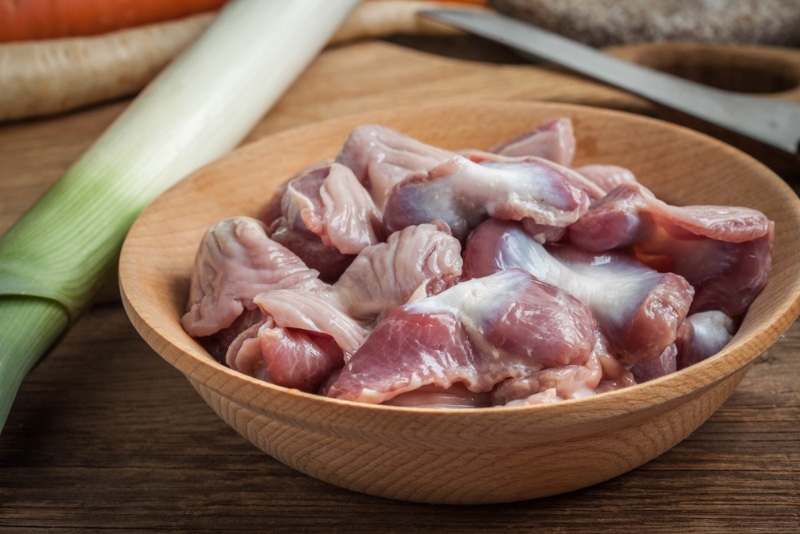Can Cats Eat Chicken Gizzards? Vet-Approved Facts & FAQ
Updated on

Click to Skip Ahead
Variety is the spice of life, whether human or cat. If you want to give your cat new food now and then to keep him interested in meal times, you may wonder if chicken gizzards are appropriate.
While your cat shouldn’t eat gizzards daily, they contain many vital nutrients he needs to thrive. Read on to learn about the benefits and risks of offering chicken gizzards and how to prepare them for your feline.
What Are Chicken Gizzards?
The gizzard is a muscular organ in a chicken’s digestive tract. Chickens peck at their food when they eat, inevitably swallowing small bits of grit and gravel. These small, sand-sized particles play an important part in a chicken’s digestion. This grit travels through the digestive tract, eventually winding up in the gizzard alongside the food. The gizzard then contracts and grinds up the food, aided by the sand-like grit. Food then passes through to the small intestine, where the nutrients are absorbed.

What Nutrients Are in Chicken Gizzards?
Chicken gizzards are a nutritious organ meat. They’re full of protein, low in fat, and provide a great source of vitamins and minerals. They’re naturally carbohydrate-free and are low in calories. According to the USDA, a 100-gram portion of chicken gizzards contains 94 calories, 17.7 grams of protein, 2 grams of fat, and 0 carbs.1
The 3 Benefits of Chicken Gizzards for Cats
1. Good Macronutrient Content
As you already know, chicken gizzards are high in protein and low in fat and carbohydrates, meaning they contain a good balance of macronutrients for cats.
2. High in Nutrients Cats Need
Chicken gizzards are a great source of nutrients like iron, selenium, magnesium, and vitamin B12.
- Iron is necessary for the formation of hemoglobin, the part of red blood cells that transports oxygen.
- Selenium is an antioxidant.
- Magnesium is important for enzyme function and the metabolism of macronutrients.
- Vitamin B12 is required for many enzyme processes.
3. Natural Source of Glucosamine
Chicken gizzards are a natural source of glucosamine, which can support your kitty’s joint health. Glucosamine can act as a mild anti-inflammatory, and the joints can use it to make cartilage components.

The 3 Risks of Feeding Chicken Gizzards
1. Not Ideal for Cats With Renal Issues
Organ meats are highly nutritious for healthy cats but can be dangerous for those with kidney issues. Gizzards are especially concerning as they are high in phosphorus. We highly recommend speaking with your vet before offering gizzards if you suspect or know your cat has kidney problems.
2. High in Cholesterol
Chicken gizzards are higher in cholesterol than other cuts of poultry and so may not be a suitable treat for all cats. Check with your vet before offering new foods such as gizzards to make sure they are suitable for your feline companion.
3. Not Recommended in High Quantities
Chicken gizzards are a great, nutritious option for healthy cats, but they should only have it occasionally as it is not a nutritionally complete meal for them. Cats need vital nutrients that gizzards alone cannot provide.
How to Prepare Chicken Gizzards for Cats
Though raw meat is a great source of nutrients for cats, it’s not recommended because it is a possible vehicle for toxoplasmosis and bacteria, including Campylobacter and Salmonella.
Therefore, if you want to offer your kitty chicken gizzards for a snack, we highly recommend cooking them. Additionally, cooking the meat can help make the texture easier and faster for your kitty to digest.
- Before cooking the gizzard, make sure it is completely cleaned. Remember, gizzards used to contain stones and dirt, so you shouldn’t skip this step.
- Cut the gizzard in half, clearing away any undesirable things you find there.
- Cut off the tough white membrane.
- Chop up the gizzard into small cubes so they’re easier for your kitty to eat.
- Once chopped, you can store the pieces in the freezer. If you’re ready to cook them, boil them to ensure you’ve removed any harmful bacteria.

Final Thoughts
Chicken gizzards are a healthy treat you can offer your cat occasionally. They’re chock full of protein and nutrients that cats need to thrive, but gizzards are high in cholesterol and not a nutritionally complete food, so they shouldn’t be the only thing your kitty eats. If your pet has health conditions, we recommend speaking with your vet before introducing new foods.
Featured Image Credit: jreika, Shutterstock












